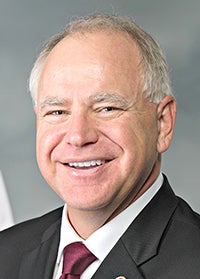Walz ready to end stay-home order, keep dine-out ban
Published 5:57 pm Wednesday, May 13, 2020
|
Getting your Trinity Audio player ready...
|
By Brian Bakst, Minnesota Public Radio News
Gov. Tim Walz will let his stay-at-home order expire as planned on Sunday night, rather than adding on more time to slow transmission of the coronavirus.

Tim Walz
In a 6 p.m broadcast to the state, the governor confirmed what sources had told MPR News earlier in the day: A new plan will let retail businesses resume in-store operations at reduced capacity, starting Monday. Group gatherings of 10 or fewer people, including at places of worship, will be allowed.
However, even with the relaxed rules, Walz will keep in place restrictions on restaurants, bars, theaters, bowling alleys and venues that attract large crowds.
“We’re not flipping a switch and everything’s going back to normal at once,” he said in his broadcast address.
The DFL governor won’t permit restaurants to legally resume dine-in service for now, keeping them takeout-only. He said that he’s instructed his agencies to assemble guidance for bar, restaurant and other venue openings in coming weeks.
According to Walz’s order, a plan for a “limited and safe” reopening of bars, restaurants and other places of public accommodation June 1 will be presented to the public no later than May 20.
When they do come back, those establishments are likely to face capacity limits.
Walz also said he signed an executive order ensuring that people can raise safety concerns about their workplaces without discrimination or retaliation.
It’s a similar situation for hair salons and barber shops, gyms and other currently restricted activities that haven’t been able to serve customers since March.
During his Wednesday evening address, Walz praised Minnesotans for toughing it out the past two months, saying the stay-home order keeping Minnesotans from congregating in crowded public places had helped check the spread of the disease, saved thousands of lives and bought Minnesota time to secure needed health care supplies and prepare for a surge of COVID-19 hospitalizations.
He acknowledged that the move had cost tens of thousands of Minnesotans their jobs as retail, hospitality and other sectors shut down.
Even as he announced the end of the stay-at-home order, he pleaded with Minnesotans to stay smart about being safe. He said he was counting on people to work from home if possible, wear masks out, stay 6 feet from others even when you’re in groups of 10 or fewer and get tested if you show symptoms of COVID-19.
“We are still in the heart of this pandemic and this can go in a bad direction quickly,” he said. The goal, he added, was to keep the spread of the disease to a simmer and not a boil.
Deaths, cases continue to climb
News of Walz’s plans comes as Minnesota’s COVID-19 toll continued its harsh ascent. The Health Department reported 638 deaths, 24 more than Tuesday, while the total number of cases since the pandemic began approached 13,000. COVID-19 is the disease caused by the coronavirus.
Minnesotans currently hospitalized (494) and needing intensive care (199) stayed roughly stable from the prior day.
Officials for the first time also began noting probable COVID-19 deaths, where the disease was listed as the cause of death but a positive test wasn’t documented. The department listed nine probable deaths.
New modeling, new approach
Walz’s shift in approach also comes as state health officials released new modeling that showed only modest differences in potential deaths if the stay-at-home mandate was stretched out for two more weeks.
It found that social distancing and similar mitigation hadn’t been as effective at curbing infection as once thought.
Since March, Walz has issued a series of executive actions that disrupted daily life, closed school buildings for the year and led to a surge in unemployment. The goal was to push off a COVID-19 peak until hospitals could stock up on protective gear and stage for a growth in intensive care beds.
Republicans have increasingly lashed out at what they see as a go-it-alone-approach by Walz. On a day in which he was set to extend by 30 days his peacetime emergency declaration — the foundation for his other response measures — a Senate committee backed a bill to change how future emergencies are handled.
The Legislature would have greater control to dictate the length of such an order.
“I’m not saying Governor Walz is a king,” said Sen. David Osmek, R-Mound. “But I am saying that we as a legislative body must have our power, our authority. We are not just a rubber stamp for whatever the governor or whatever the executive branch wants to do.”
Sen. Jim Carlson, DFL-Eagan, dismissed the bill as a partisan play given that Senate leaders and the governor are of competing parties.
“We’re involved in a very, very serious crisis and what we don’t need to do is add politics to it,” Carlson said.
Osmek responded that he would be pushing the bill even if a Republican governor was in office.


